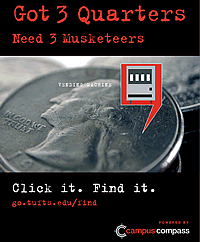2006 Campus Technology Innovators: Web Tools

TECHNOLOGY AREA: WEB TOOLS
Innovator: Tufts University

THE CAMPUS COMPASS project sprang
to
life in a collective "ah-hah" moment during
a brainstorming session.
Challenge Met
In early August 2005, with the tide of incoming
freshmen just a few weeks away, Tufts
University (MA) needed to provide more
than just driving directions to campus: Once
there, the students would also have to find
their way to all the services and features the
school has to offer. The Campus Compass
project sprang to life in a collective “ah-hah”
moment during a brainstorming session at
which Department of Web Communications
staff connected this need for campus information
and navigation with the new, freely
available Google Maps API. After only a couple hours
of discussion, the group had a plan of attack.
Two weeks later, they had the Campus Compass
website.
In the true spirit of Web 2.0 (the second
generation of the web, characterized by
shared information
and interoperable
services)
Tufts leveraged
Google’s sophisticated
mapping
technology and
coordinated it with
university information
as a “mashup,”
complete with
satellite images,
informative links,
category searches,
and cool icons. Web
content creators and
application developers
had efficiently produced a resource that
enables prospective and current students,
staff, faculty, campus visitors, community
members, and others to explore the campus
online and locate buildings and services
from WiFi hotspots and ATM machines, to
Zipcar locations and
more.
How They Did It
Campus Compass was a grassroots initiative
of the Department of Web Communications,
directed by Pete Sanborn with the
encouragement of the University Relations
division and other administrators at Tufts.
Senior Web Applications Developer Teresa
Loftin led the technical development.
Content specialists and web developers
worked side by side. The content team collected
and organized data. Student interns
armed with handheld GPS units combed the
campus seeking out every bike rack, pingpong
table, vending machine, and tennis
court they could find—plus a long list of
other “mappable” items and points of interest.
The technical team created the database
and the application that is used to overlay
data points on Google Maps. It wasn’t long
before 586 items were mapped across the
Medford/Somerville campus.
Developers chose PHP and MySQL to create the data backend for
Campus Compass because it’s a coding
environment they’re familiar with, and one
that they could customize to their specific
needs. They built a management application
to store Campus Compass data (e.g.,
categories, data points, GPS coordinates,
and so forth), and using the Google Maps
API, they were able to render the data points
on the Campus Compass application. While
the Google Maps API only requires data
points and coordinates, the Tufts team built
an application that could be rendered and
updated dynamically through an easy-touse
web-based interface rather than forcing
non-technical staff and students to update
multiple XML files.
Finally, the Campus Compass team
invited coordinators of special events, including
Homecoming, Parents Weekend, and
Commencement to promote their events
through tailor-made maps targeting each of
their audiences.
Next Steps
The team will expand the amount of information
in the Campus Compass database and
extend mapping capabilities to its downtown
Boston and Grafton campuses. They also
hope to integrate the university-wide events
calendar more closely, to create a dynamic
tool for finding out what’s going on “when and
where,” and to aid campus visitors.
Advice
Google Maps “mash-ups” are still in relatively
uncharted territory, but don’t be afraid,
says the Campus Compass team—and use
online discussion groups as a resource.